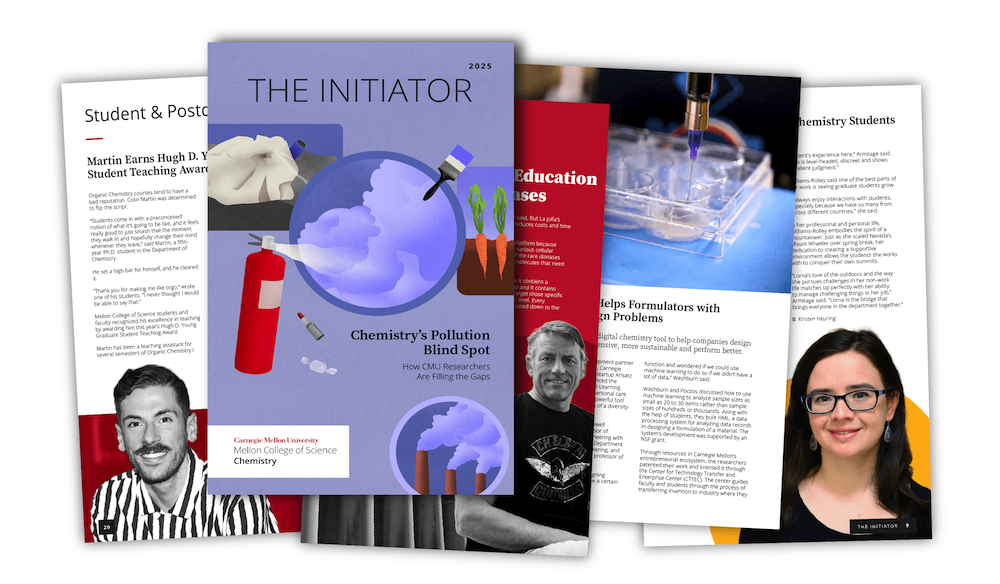CMU Researchers, Team Win Royal Society of Chemistry Prize
Associate Professor Alex Guo, researcher Jin Xiong and their international collaborators received the Dalton Horizon Prize for discovering new ligands for oxidation chemistry
By Amy Pavlak Laird
Media Inquiries- Associate Dean of Marketing and Communications, MCS
- 412-268-9982
Enzymes make difficult chemistry look easy. They control chemical reactions with exquisite precision and speed, something that chemists strive — but often fail — to do with molecules they create in the lab.
Carnegie Mellon University’s Yisong (Alex) Guo and collaborators at the University of Minnesota and the Universitat de Girona have unlocked new understanding of how to design synthetic model systems to replicate, and in some cases even surpass, the efficiency of the enzymes that nature has spent millennia perfecting. Their work opens the door to designing even more effective iron-based catalysts for use in sustainable synthesis and industrial applications.
The team’s work was recognized with a Royal Society of Chemistry’s Horizon Prize, which celebrates discoveries and innovations that push the boundaries of science. This year’s winners join a prestigious list of past winners in the RSC’s prize portfolio, 60 of whom have gone on to win Nobel Prizes.
The natural world — from bacteria and fungi to humans — uses metal-containing enzymes to power many biological processes, including photosynthesis, respiration and gene regulation. Chemists are keen to understand how these enzymes work so that they can recreate them in the lab to carry out important, yet challenging, chemical transformations.
The award-winning team investigates how certain iron-based enzymes work, especially how they use iron and oxygen to change carbon–hydrogen (C–H) bonds in other molecules. This ability to selectively modify C–H bonds is key to generating useful industrial precursors for a variety of uses or for degrading environmental toxins.
To better understand and replicate how enzymes do this complicated transformation, the research team built artificial versions of the active parts of these enzymes. Using a combination of chemical synthesis, spectroscopy and computer modeling, the team explored how these artificial systems work.
“We had a very close collaboration with complementary expertise that enabled us to put together all of the puzzle pieces as to why the molecules behave the way they do,” said Guo, an associate professor in the Department of Chemistry. “This is a very important strategy for finding new scientific discoveries.”
Traditionally, scientists believed that the most reactive iron-oxygen complexes were those with a specific electronic configuration known as a "quintet ground state." But the team’s research shows that even small tweaks in the shape or structure of the cage-like molecules surrounding the iron center (called ligands) can have a big impact on how reactive the iron-oxygen compounds are.
The researchers discovered that, in one particular case, a single change in the ligand increased the speed of the reaction by two to three orders of magnitude. The team’s systematic, detailed study of the ligands enabled such a fundamental discovery, said Guo.
This shift in understanding could inform the design of more efficient catalysts, thus reducing environmental impact and improving sustainability.
“The ultimate outcome of this work may reduce the cost of chemical or biological syntheses through more efficient C–H activation methodologies, which lower material and energy consumption. In particular, it could help decrease the cost of developing and producing medications, as well as other high-value chemical products,” said Jin Xiong, a postdoctoral research associate in Guo’s lab and a co-winner of the award.
Xiong and Guo carried out detailed spectroscopic analysis of high-valent nonheme iron enzymes and their corresponding synthetic analogs. Guo lab members are experts in using multiple spectroscopic techniques, such as Mössbauer, Electron Paramagnetic Resonance (EPR) and synchrotron radiation-based spectroscopic techniques, to understand the mechanisms of the chemical transformations catalyzed on the metal centers inside metalloproteins.
“Synthetic chemistry can do a lot of interesting, magical things to create new molecules. But then we need to look deeper with spectroscopic characterization and computational modeling to understand the molecules’ behavior so that everything can come together to inform the next step — to improve the molecule or to spot the bottleneck so that we can move toward a real-world application,” Guo said.
The Dalton Horizon Prize recognizes significant recent novel discoveries or advances made in the field of inorganic chemistry. In addition to Guo and Xiong, the prize-winning team consists of: Marcel Swart, Faiza Ahsan, Mehmet Jahja and Sami Mahri from the Universitat de Girona; and Lawrence Que Jr., Bittu Chandra, Abhishek Das, Nabhendu Pal, Yuan Sheng, and Victor G. Young from the University of Minnesota.
Both Guo and Que, a Regents Professor Emeritus in the Department of Chemistry at the University of Minnesota, completed postdoctoral work — although more than 30 years apart — under the supervision of Carnegie Mellon Emeritus Professor of Chemistry Eckard Münck. Well known for his pioneering work on the biophysical properties of metalloproteins, Münck established Mössbauer spectroscopy as a potent tool for studying proteins that contain complex iron centers.

